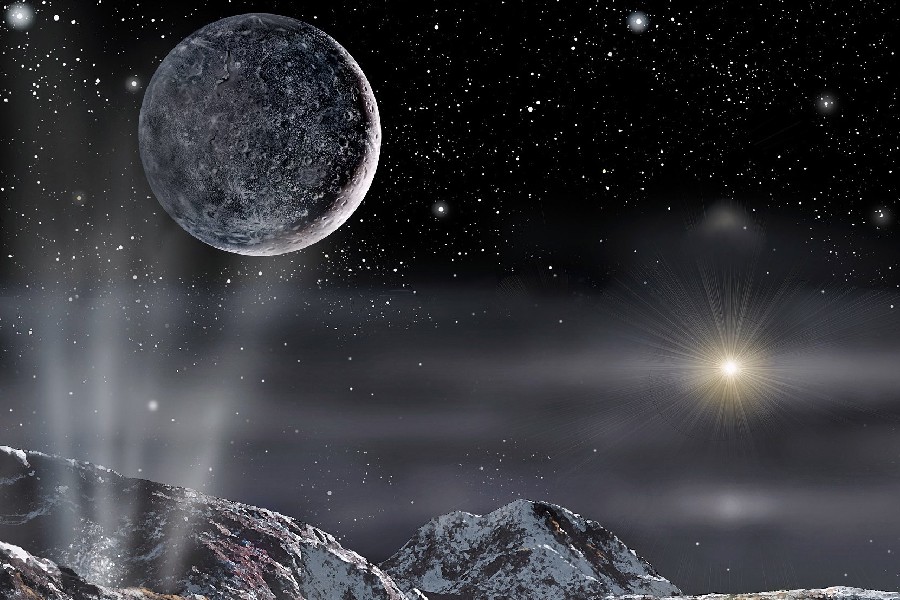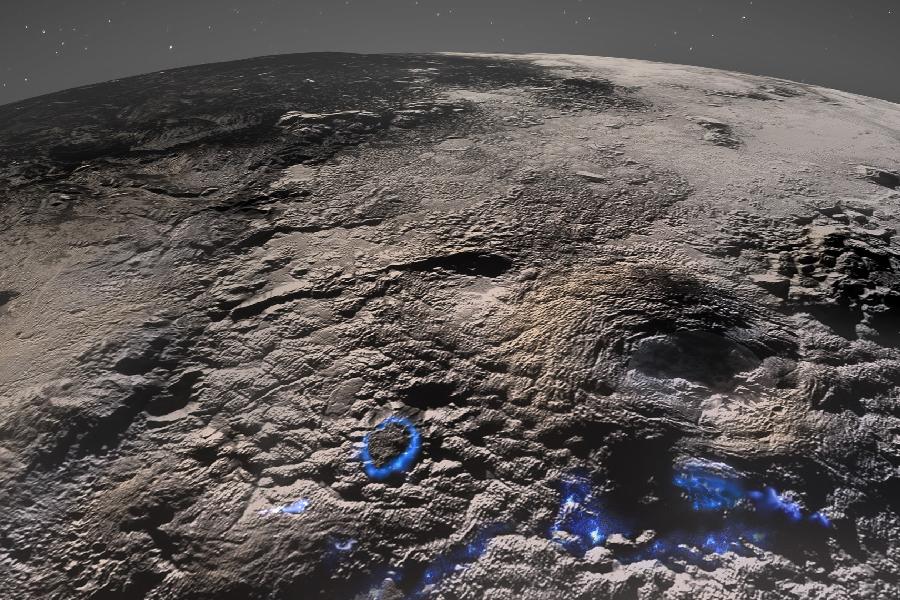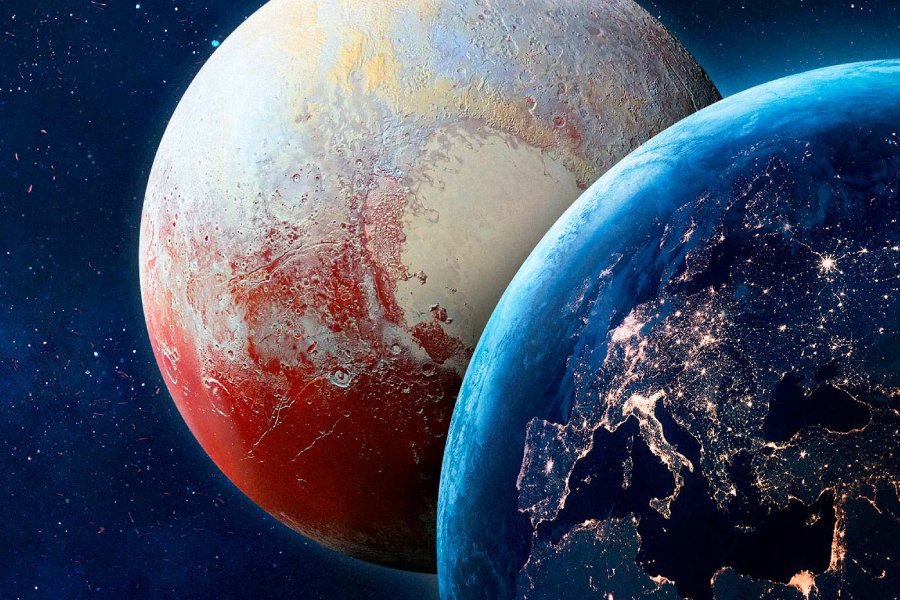Far beyond the orbit of Neptune lies Pluto, a frigid, diminutive dwarf planet shrouded in mystery. Though lacking a vigorous atmosphere, Pluto manifests subtle seasonal changes over its long centuries-spanning years. So, what is the Pluto climate like? Does Pluto have wind?
This article explores scientists’ understanding of Pluto’s harsh climate. We will discuss the latest discoveries about quirky features and mysteries of its climate.

Pluto Climate
Pluto’s climate is extremely cold, with an average surface temperature of -387 °F (-232 °C) due to its distance from the Sun. But is Pluto windy?
Yes, Pluto experiences winds, but they are relatively gentle due to its thin atmosphere. The wind speeds on Pluto are estimated to be less than 10 miles per hour (16 kilometers per hour).
Moreover, the thin atmosphere, composed of nitrogen, methane, and carbon monoxide, experiences seasonal changes during Pluto’s orbit. Despite its frigid conditions, Pluto’s climate intrigues astronomers studying the outer solar system, thanks to the 2015 New Horizons flyby data.
Extreme Cold Conditions on Pluto
The intense cold on Pluto permits the presence of exotic ices such as nitrogen, methane, and carbon monoxide on its surfaces. As Pluto moves away from the Sun, the freezing temperatures plummet further. This increased cold causes gases from the sparse atmosphere to freeze, forming a layer of snow and frost.
Hence, the most volatile elements, such as nitrogen and methane, condense first, creating an icy surface. Meanwhile, carbon monoxide frost lingers closer to the relatively warmer equatorial zones.
Geological Activity and Cryovolcanism
Nitrogen, methane, and water ices mold Pluto’s shifting landscapes over eons through processes like glaciation, sublimation, and erosion. Water-ice bedrock also experiences convection, causing geological activity and features.
Furthermore, some cryovolcanic candidate regions may erupt molten icy flows. These could be flows like icy ammonia or methylated liquid water lavas. They could contribute to methane presence in the atmosphere long term.
Distinct surface colorations, formations, and flows around Wright/Piccard Mons resemble terrestrial volcanic pampas. This prompts theories regarding cryolavas extruding, eroding then refreezing into current visible terrain.
Seasonal Variations and Surface Temperature Changes
Dramatic orbital temperature shifts
Pluto’s 248-year path around the Sun stretches from 30 AU to 50 AU. This means wide temperature swings between more distant cooler periods and nearer closer approaches.
The large northern tropical region called Tombaugh Regio experiences major seasonal changes in the transport of volatile ice and precipitation. The darker Equatorial Band south of Tombaugh Regio also has large seasonal shifts in volatile movement and precipitation.
This exposes brighter water ice bedrock when frost sublimes. Then frost re-accumulates later in seasonal cold snaps over long cycles measured in Earth decades due to Pluto’s distant orbit.
Hemispheric variations
High northern latitude zones undergo more acute seasonal shifts, dramatically changing insulation and insolation levels between extended winters and summers. Atmospheric circulation also transports more volatiles like methane poleward seasonally.
On the contrary, equatorial regions on Pluto undergo minimal seasonal temperature fluctuations despite its significant axial tilt. These equatorial bands exhibit a steadier accumulation of carbon monoxide frost with less pronounced annual flux.

Factors Influencing Pluto’s Temperature
Examination of atmospheric conditions
Pluto’s atmosphere, composed of thin layers of nitrogen, methane, and carbon monoxide, is crucial in modifying surface temperatures by providing insulation. Variations in pressure impact the mobility of volatile elements, causing shifts in compositions and frost deposition in different regions.
Additionally, localized concentrations diverge across altitudes and seasons as gases freeze or transition into vapor phases.
Volatile transport dynamics
In cooler equatorial regions, solid carbon monoxide frost endures longer during warmer periods than quickly vaporizing polar methane ice. The complex global circulation unevenly transports volatiles, resulting in regional temperature extremes exceeding 100 degrees Celsius, influenced by the eccentric orbit.
Furthermore, atmospheric abundance plays a crucial role in the fluctuations between warming and cooling. The high volatility differential between methane and nitrogen induces uneven atmospheric freezing and concentration, driving hemispheric seasonal variations. Also, equatorial areas act as cold traps, selectively accumulating less volatile ice.
Local concentration fluctuations
As gasses sublimate from warmer zones, circulating winds transport them elsewhere, prompting deposits realigning with temperature gradients. Temporary abundance spikes occur around perihelion passages before diminishing toward aphelions. Diurnal retreats also emerge as molecules settle nightly, impacting local climate variations.
Thin Atmosphere of Pluto
Pluto possesses an extremely thin atmosphere measuring barely one millionth of Earth’s. Tenuous nitrogen, methane, and carbon monoxide envelope stems from ice sublimating when warmer. And sparse gasses struggle to retain heat, hence the prominent frosts and icy terrains.
Significant atmosphere loss also occurred early in Pluto’s history when warmer, possibly hampering volatile retention relative to bigger Kuiper Belt denizens. So, measurement is difficult given the slight, cold gasses prone to refreezing and recondensing quickly.
Composition and Behavior of Pluto’s Atmosphere
Pluto’s atmosphere undergoes seasonal and surface variations. The Equator remains consistently colder, hosting solid carbon monoxide frost. Warmer polar zones feature nitrogen and methane gases circulating with the changing seasons.
Pluto’s elliptical orbit leads to atmospheric pressure spikes near perihelion. During the slower aphelion phases, minimal gases linger. Gases rise and freeze out daily despite the planet’s extended days. This uneven distribution persists across latitudes and altitudes.
Molecular nitrogen, highly volatile, dominates despite its lower surface abundance. Heavier methane falls out faster, while lighter gases transport more readily across Pluto’s diverse cold traps. Each element significantly contributes to the intricate unfolding of seasonal cycles.
Interaction With Solar Radiation
Pluto, situated much farther from the Sun than Earth, experiences reduced solar energy input across its extended seasons. As axial tilt shifts, lower solar angles during northern winter decrease radiation absorption. Subsurface heat, likely sustained by complex seasons and radioactivity, prevents atmospheric collapse in the distant, faint sunlight.
Despite exceptionally low temperatures, ices reshape surface features without liquid flows, preserving buried warmth. Surprisingly, vast heart-shaped nitrogen ice fields hint at complexity emerging from dim, distant insolation. The dwarf planet defies solid freezing, staying over 100 Kelvins cold, thanks to radioactive elements in its mantle.
Moreover, Pluto’s elliptical orbit spans a steep temperature gradient, inducing exotic phase changes in molecular gases during its long solar year. Extended seasons trigger volatile element redistribution between solid, liquid, and vapor states, with the atmosphere freezing and sublimating over decades-long cycles.

Comparison With Earth and Other Celestial Bodies
Contrasting Pluto’s climate with terrestrial planets
Pluto’s climate sets it apart from Earth and the inner planets. Frigid temperatures plummeting below -390 °F define this tiny world. Nitrogen and methane ice shape regional weather patterns on its surface. With a 248-year orbit around the distant Sun, Pluto experiences more extreme seasons.
In stark contrast to gas giants, Pluto lacks an internal heat source. Its atmosphere freezes to the surface, unlike the gaseous atmospheres of fellow planets. Icy volcanism and evaporating ice replace aqueous dynamics. Despite its small, cold nature, complex climates can emerge on Pluto and similar spheres.
Unique climate features of the Kuiper Belt
Ranked as the second largest Kuiper Belt Object, dwarf planet Eris takes the lead. Comparisons with Pluto and its frosty neighbors offer climate insights in this frigid expanse. Seasonal shifts unfold, shaped by volatile ices, elongated orbits, and vast distances.
Methane layers, haze and extremely low temperatures unite many Kuiper Belt denizens. Contrasts illuminate our remote outer solar system’s third zone.
Yet Pluto continues to astound: unlike any other KBO, its multi-lobed, formerly geologically active heart circles the dazzling Charon companion. Perhaps more exoplanet than a mere asteroid, the rich climate variations of this tiny twilight world hint at more wonders in the uncharted frontiers beyond.
Frequently Asked Questions
Is Pluto always cold?
Yes, Pluto has an extremely cold global climate, with average surface temperatures around -380 °F (230 °C), quite cold enough to freeze nitrogen and methane ice solid. Over a full Pluto day lasting about six Earth days, temperatures vary only slightly. These frigid temperatures would be deadly for humans without special protection.
Are there weather patterns on Pluto?
While Pluto has an extremely thin atmosphere of nitrogen, methane and hydrocarbons, this atmosphere exhibits some weather patterns. These include regional transport of volatile ices and cycles of precipitation.
The atmosphere also shows the formation of haze effects. All these create intriguing weather patterns on Pluto that mirror seasonal climate change.
Ices may migrate from equatorial to tropical regions and back based on Pluto’s high orbital eccentricity and extreme axial tilt. This creates substantial contrast in seasonal insolation.
Does Pluto have storms?
No major storms have been directly observed in Pluto’s modest nitrogen atmosphere. However, some atmospheric models suggest small localized snow storms could sporadically arise.
This phenomenon is more likely when pockets of convectively rising air induce increased wind speeds. These higher winds can then mobilize surface ice grains, leading to brief but noticeable blowing storms that eventually disperse.
Why does Pluto have a thin atmosphere?
Pluto’s small size and very low gravity prevent it from acquiring and retaining a lasting thicker atmosphere with heavier molecules over extended periods of time. Its little atmosphere will freeze and collapse to the frigid surface when Pluto travels farther from the Sun.
This is because it moves farther from the heating effects of the distant Sun. When periodically closer to perihelion, surface ice temporarily enters the gas phase to supply the planet’s weather.
What role does Pluto’s atmosphere play?
The thin nitrogen-dominant atmosphere with traces of methane and hydrocarbons enables a degree of volatile transport around the planet. This helps to circulate and drive seasonal ice migration and precipitation changes. Density variations in atmospheric composition also create haze effects at higher altitudes, producing dimmer illumination at surface levels.
Conclusion
Pluto has a wide range of cold weather patterns, called Pluto climate. The climate includes things like dunes of frozen methane that drift. It also includes bright bands of unique frozen condensates. These coat the peaks and plains of the tiny frozen world of Pluto.
We explained the many different weather factors shaping Pluto. These factors include hazy cycles of frost and blizzards of organic snow. They also include cooling and heating cycles over six Earth-day periods on Pluto. This creates an intricate dance of frigid ice swaying amid perpetual night on Pluto’s remote, distant orb.
Just as complex climate phenomena shape Earth’s diverse biomes, so does Pluto’s climate govern a marvelous array of alien vistas on the very frontier of the Sun’s reign. The sublime eccentricities of this little planet’s patterns and fluxes highlight the wonders awaiting discovery across our solar system’s untrodden vastness.
